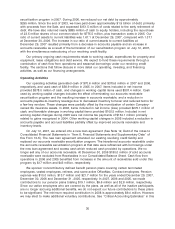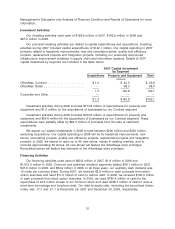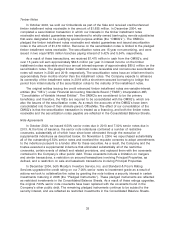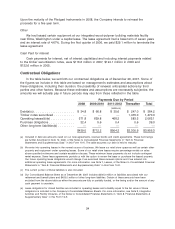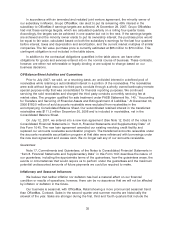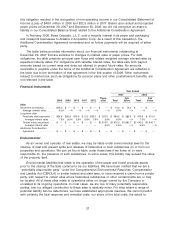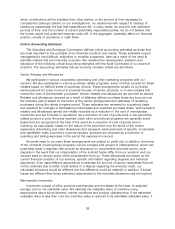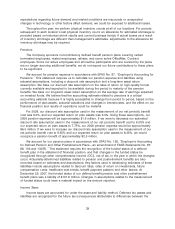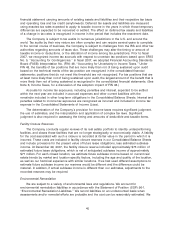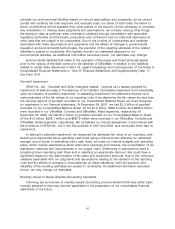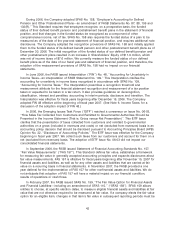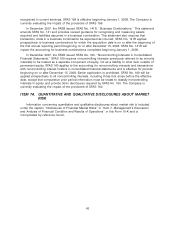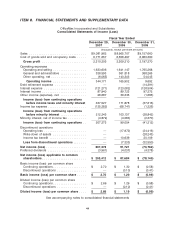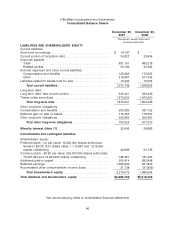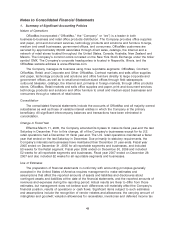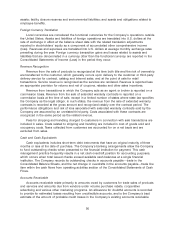OfficeMax 2007 Annual Report Download - page 44
Download and view the complete annual report
Please find page 44 of the 2007 OfficeMax annual report below. You can navigate through the pages in the report by either clicking on the pages listed below, or by using the keyword search tool below to find specific information within the annual report.financial statement carrying amounts of existing assets and liabilities and their respective tax basis
and operating loss and tax credit carryforwards. Deferred tax assets and liabilities are measured
using enacted tax rates expected to apply to taxable income in the years in which those temporary
differences are expected to be recovered or settled. The effect on deferred tax assets and liabilities
of a change in tax rates is recognized in income in the period that includes the enactment date.
The Company is subject to tax audits in numerous jurisdictions in the U.S. and around the
world. Tax audits by their very nature are often complex and can require several years to complete.
In the normal course of business, the Company is subject to challenges from the IRS and other tax
authorities regarding amounts of taxes due. These challenges may alter the timing or amount of
taxable income or deductions, or the allocation of income among tax jurisdictions. Prior to fiscal
2007, we recognized income tax accruals with respect to uncertain tax positions based upon SFAS
No. 5, ‘‘Accounting for Contingencies.’’ In fiscal 2007, we adopted Financial Accounting Standards
Board (FASB) Interpretation No. (FIN) 48, ‘‘Accounting for Uncertainty in Income Taxes.’’ Under
FIN 48, the benefits of tax positions that are more likely than not of being sustained upon audit
based on the technical merits of the tax position are recognized in the consolidated financial
statements; positions that do not meet this threshold are not recognized. For tax positions that are
at least more likely than not of being sustained upon audit, the largest amount of the benefit that is
more likely than not of being sustained is recognized in the consolidated financial statements. (See
Note 6, Income Taxes, for a discussion of the adoption impact of FIN 48.)
Accruals for income tax exposures, including penalties and interest, expected to be settled
within the next year are included in accrued expenses and other current liabilities with the
remainder included in other long-term obligations in the Consolidated Balance Sheets. Interest and
penalties related to income tax exposures are recognized as incurred and included in income tax
expense in the Consolidated Statements of Income (Loss).
The determination of the Company’s provision for income taxes requires significant judgment,
the use of estimates, and the interpretation and application of complex tax laws. Significant
judgment is also required in assessing the timing and amounts of deductible and taxable items.
Facility Closure Reserves
The Company conducts regular reviews of its real estate portfolio to identify underperforming
facilities, and closes those facilities that are no longer strategically or economically viable. A liability
for the cost associated with such a closure is recorded at its fair value in the period in which it is
incurred. These costs are included in facility closure reserves in our Consolidated Balance Sheets
and include provisions for the present value of future lease obligations, less estimated sublease
income. At December 29, 2007, the facility closure reserve included approximately $73 million of
estimated future lease obligations, which is net of anticipated sublease income of approximately
$77 million. For each closed location, we estimate future sublease income based on current real
estate trends by market and location-specific factors, including the age and quality of the location,
as well as our historical experience with similar locations. If we had used different assumptions to
estimate future sublease income our reserves would be different and the difference could be
material. In addition, if actual sublease income is different than our estimates, adjustments to the
recorded reserves may be required.
Environmental Remediation
We are subject to a variety of environmental laws and regulations. We account for
environmental remediation liabilities in accordance with the Statement of Position (SOP) 96-1,
‘‘Environmental Remediation Liabilities.’’ We record liabilities on an undiscounted basis when
assessments and/or remedial efforts are probable and the cost can be reasonably estimated. We
40


